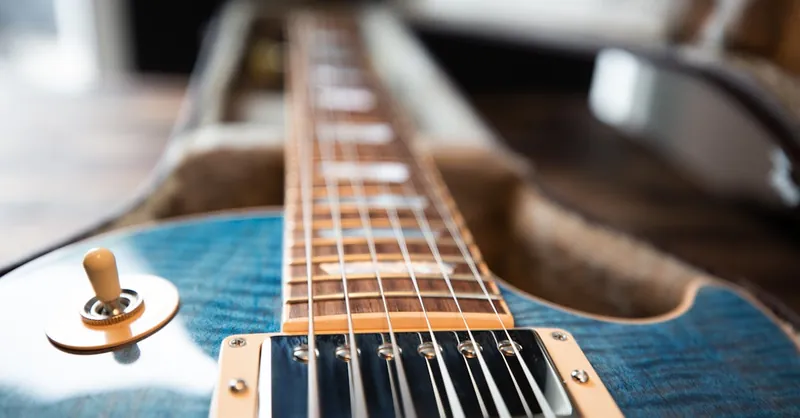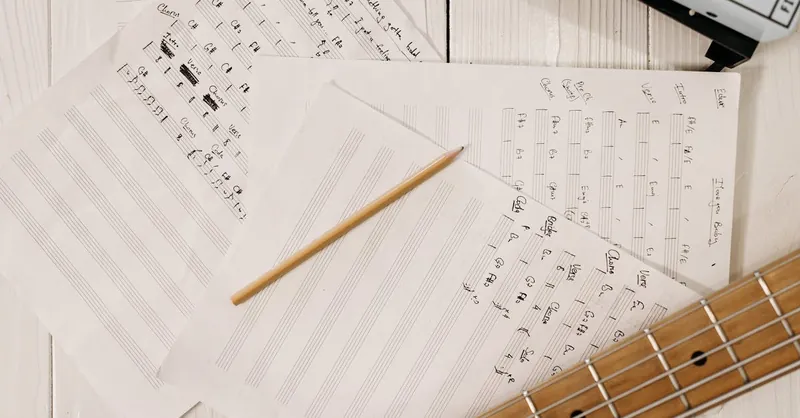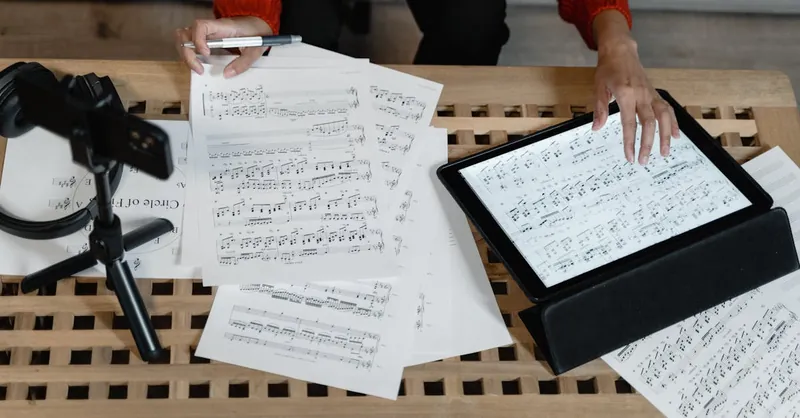Easy Music Theory Lessons for Guitar Beginners
Category: Music Theory
Unlock the Secrets of Guitar Music Theory with Ease
If you're a beginner guitarist or a music enthusiast craving a clear and simple path to mastering music theory, you’ve landed in the right spot. Many new guitar players find themselves overwhelmed by complex theory jargon and abstract concepts that seem to have no immediate connection to playing. You likely came here searching for straightforward, practical lessons that make music theory applicable and fun on your guitar.
This guide breaks down essential music theory focusing on guitar, using beginner-friendly language and clear examples. Whether you’re struggling to understand scales, chords, or how music fits together on the fretboard, this post offers a step-by-step approach to transform confusion into confidence. We’ll connect theoretical concepts directly to guitar techniques, ensuring that each lesson is relevant and actionable.
Unlike other resources packed with dense explanations, we emphasize clarity and practical application—helping you play better and understand deeper without frustration. Plus, complementary insights for piano players create a well-rounded musical foundation. If you're ready to improve your guitar skills through easy-to-digest music theory lessons that actually make sense, keep reading. Your journey to playing smarter starts here.
- Unlock the Secrets of Guitar Music Theory with Ease
- Understanding the Basics: Notes, Intervals, and the Musical Alphabet
- The Guitar Fretboard Explained: Mapping Notes and Intervals Visually on Your Guitar Neck for Easy Recognition
- Major and Minor Scales Made Simple: How to Build and Play Them on Guitar and Why They Matter
- Chord Construction 101: Building Major, Minor, and Basic Chords from Scales for Guitar Beginners
- Common Guitar Chord Progressions: How to Recognize and Practice Them Using Music Theory
- Reading Rhythm and Timing: Basic Note Values, Time Signatures, and How They Drive Guitar Playing
- Using Theory to Improve Guitar Improvisation: Applying Scales and Chords Creatively in Practice
- Connecting Guitar and Piano Theory: How Understanding Both Instruments Reinforces Your Music Knowledge
- Tips for Practicing Music Theory on Guitar: Efficient Exercises, Learning Tools, and Consistency Strategies
- Resources and Next Steps: Recommended Books, Apps, and Tutorials to Deepen Your Music Theory Skills
Understanding the Basics: Notes, Intervals, and the Musical Alphabet
Before diving into chords and scales on the guitar, it’s essential to grasp the fundamental building blocks of music theory: notes, intervals, and the musical alphabet. These concepts serve as your roadmap to navigating the fretboard with confidence and purpose.
The Musical Alphabet and Guitar Notes
The musical alphabet consists of seven natural notes: A, B, C, D, E, F, and G. After G, the cycle repeats back to A, creating a continuous loop. On the guitar, each fret represents a half-step movement to the next note in this sequence. Understanding this repetition helps you identify notes on the fretboard and build chords or scales more intuitively.
What Are Intervals?
An interval is the distance between two notes, measured in half-steps (frets) or whole steps (two frets). Intervals shape the sound of melodies and chords, giving them their unique character. For example:
- A half-step interval (1 fret) creates a very close, sometimes tense sound.
- A whole-step interval (2 frets) forms the basis for most scales and harmonies.
By learning how intervals work, you can start recognizing how notes relate to each other on your guitar and construct musical pieces with intentional sound patterns.
Applying These Concepts to Your Guitar
- Start by memorizing the notes on the low E string, then the A string – these provide a strong foundation for scale patterns.
- Practice identifying intervals between notes on the same string and across strings.
- Use the musical alphabet and interval knowledge to build simple scales like the major scale or basic chords like the major triad.
Mastering notes, intervals, and the musical alphabet is the first step in demystifying guitar music theory. With these basics firmly in place, your journey toward playing and understanding music will become clearer and more rewarding.

Image courtesy of Rene Terp
The Guitar Fretboard Explained: Mapping Notes and Intervals Visually on Your Guitar Neck for Easy Recognition
To truly master guitar music theory, it’s critical to visualize the fretboard as a map of notes and intervals rather than just frets and strings. Each position on your guitar neck corresponds to a specific note, and understanding this mapping not only accelerates learning but also boosts your improvisation and composition skills.
Visualizing Notes on the Fretboard
Begin by memorizing the natural notes on open strings:
- 6th string (low E) – E
- 5th string (A) – A
- 4th string (D) – D
- 3rd string (G) – G
- 2nd string (B) – B
- 1st string (high E) – E
From these anchor points, every fret moves one half-step forward in the musical alphabet: for example, the 1st fret on the low E string is F, the 2nd fret is F#, and so on. Mapping these notes across the entire fretboard transforms its complexity into a logical, repeatable pattern that you can rely on.
Understanding Intervals Across the Neck
With the notes mapped, you can then visualise interval shapes horizontally (same string) and vertically (across strings). This helps in quickly identifying key intervals such as:
- Half-step (1 fret) – the smallest interval on guitar.
- Whole-step (2 frets) – foundational in scale patterns like the major scale.
- Perfect 4th and Perfect 5th – often found between adjacent strings and crucial for chord construction.
Recognizing common interval shapes aids in locating scales and chords anywhere on the fretboard, rather than memorizing fixed patterns in one position. For instance, a major third interval appears as 4 frets on the same string or 1 string down and 3 frets up on adjacent strings. These interval "templates" form the building blocks for playing melodies, solos, and harmonies with confidence.
Practical Steps to Master Fretboard Mapping
- Memorize notes on the 6th and 5th strings first, as they serve as reference points for other strings.
- Use simple interval exercises by picking one note and locating its half-step, whole-step, and perfect fifth intervals across different strings.
- Visualize scale patterns using interval relationships rather than just fret numbers—this fosters adaptability across keys and positions.
By internalizing the fretboard as a visual map of notes and intervals, you’ll develop a deeper understanding of how music theory applies directly to your playing. This approach makes learning theory less abstract and more connected to the instrument, enabling faster progress and greater musical creativity.

Image courtesy of Artem Podrez
Major and Minor Scales Made Simple: How to Build and Play Them on Guitar and Why They Matter
If you want to unlock the heart of guitar music theory, major and minor scales are your essential foundation. These scales are the building blocks of melodies, solos, and chords in nearly every genre of music. Understanding how to construct and play them on your guitar will dramatically improve your ability to compose, improvise, and interpret songs with confidence.
What Are Major and Minor Scales?
A major scale is a sequence of notes that creates a bright, happy, and stable sound. It follows a specific pattern of intervals:
Whole, Whole, Half, Whole, Whole, Whole, Half (where "Whole" means two frets and "Half" means one fret on the guitar). For example, the C major scale contains the notes C, D, E, F, G, A, B, and back to C.
In contrast, a minor scale has a darker, more melancholic tone. The natural minor scale follows this interval pattern:
Whole, Half, Whole, Whole, Half, Whole, Whole. For example, the A minor scale consists of A, B, C, D, E, F, G, and A.
How to Build and Play Them on Guitar
To start playing these scales on your guitar:
- Choose a root note on the low E or A string to serve as your starting point (the "tonic").
- Apply the corresponding major or minor interval pattern by moving along the frets according to the whole and half steps.
- Practice the scale ascending and descending, using alternate picking for smoothness and accuracy.
Why Major and Minor Scales Matter
- They shape chords and progressions. Every major or minor chord you play comes from these scales, meaning knowing the scales helps you understand why chords sound good together.
- They provide a framework for soloing and improvisation. Once you know a scale pattern, you can confidently create melodies and solos that fit the key of the song.
- They improve fretboard knowledge. Practicing scales ingrains note locations and interval relationships, making it easier to navigate the guitar neck naturally.
Mastering major and minor scales is a vital step in your guitar journey, linking theory directly to playing. By internalizing these scales, you create a foundation for all future learning—from building chord voicings to exploring more advanced scales and modes.

Image courtesy of Pavel Danilyuk
Chord Construction 101: Building Major, Minor, and Basic Chords from Scales for Guitar Beginners
Understanding how chords are constructed from scales is a crucial next step once you’re familiar with notes, intervals, and scales on the guitar. Chords are simply groups of notes played together that create harmony, and the most common chords—major, minor, and basic triads—are built by selecting specific intervals from a scale. By learning this process, you’ll gain the ability to build your own chords anywhere on the fretboard and deepen your musical intuition.
How Are Chords Built from Scales?
Chords are formed by stacking intervals called triads, which usually consist of three notes: the root, third, and fifth. Using the major scale as a blueprint:
- Root Note: This is the starting note of your chord and defines its key (e.g., C in a C major chord).
- Major or Minor Third: This interval, found 4 frets (major third) or 3 frets (minor third) above the root, determines the chord’s basic character—major (happy/bright) or minor (sad/dark).
- Perfect Fifth: Located 7 frets above the root, this interval adds fullness and stability.
Building Basic Major and Minor Chords
- Major Chord: Root + Major Third + Perfect Fifth
For example, a C major chord contains the notes C (root), E (major third), and G (perfect fifth). - Minor Chord: Root + Minor Third + Perfect Fifth
An A minor chord consists of A (root), C (minor third), and E (perfect fifth).
Why Chord Construction Matters for Guitar Beginners
- Custom chord voicings: By understanding which notes form a chord, you can create or modify chord shapes across the fretboard beyond common open chords.
- Improved musical comprehension: Recognizing how chords relate to scales helps you understand key signature, chord progressions, and how songs are structured.
- Easier improvisation and songwriting: Knowing your chord tones guides you in selecting safe melodic notes when soloing or composing.
Quick Tip: Practice Building Triads from Scales
- Start with a C major scale played on the guitar.
- Identify the root (C), then find the third (E) and fifth (G) notes within the scale.
- Play these notes together to form the C major triad.
- Repeat this process starting from the root note of the minor scale to build minor chords.
Mastering chord construction unlocks the power to understand and play music intuitively—the key to progressing from just playing chords to truly mastering guitar harmony with music theory.

Image courtesy of Tima Miroshnichenko
Common Guitar Chord Progressions: How to Recognize and Practice Them Using Music Theory
One of the most valuable skills for any guitarist is recognizing and playing common chord progressions—the series of chords that form the backbone of countless songs across genres. By using music theory, you can understand why certain chords naturally fit together, making it easier to learn songs, write your own music, and improvise with confidence.
What Are Chord Progressions?
A chord progression is simply a sequence of chords played in a specific order. These progressions create the harmonic framework for melodies and give songs their emotional direction. Learning common progressions helps you anticipate what chords come next and understand the relationships between chords within a key.
How Music Theory Helps Identify Chord Progressions
Most popular chord progressions derive directly from the major or minor scale of the song’s key. Each scale degree corresponds to a chord built on that note, often notated using Roman numerals. For example, in the key of C major:
| Scale Degree | Note | Chord Type | Notation |
|---|---|---|---|
| 1st | C | Major | I |
| 2nd | D | Minor | ii |
| 3rd | E | Minor | iii |
| 4th | F | Major | IV |
| 5th | G | Major | V |
| 6th | A | Minor | vi |
| 7th | B | Diminished | vii° |
Understanding this system allows you to recognize common progressions like I–IV–V, which underpins many rock, pop, and blues songs, or vi–IV–I–V, the famous "pop-punk progression." This insight demystifies song structures and gives you a theoretical toolkit to transpose progressions into different keys effortlessly.
Practical Tips for Practicing Chord Progressions Using Theory
- Choose a key and identify its scale and corresponding chords using Roman numerals.
- Practice common progressions within that key, such as:
- I–IV–V (e.g., C–F–G in C major)
- ii–V–I (common in jazz, e.g., Dm–G–C in C major)
- vi–IV–I–V (e.g., Am–F–C–G in C major)
- Play the progressions using different chord voicings and positions on the fretboard to build versatility and fretboard knowledge.
- Experiment with switching keys by applying the same progression pattern starting from a different root note, reinforcing your understanding of chord functions.
- Use a metronome or backing track to develop timing and musical feel while playing chord progressions.
By mastering how to recognize and practice chord progressions through music theory, you gain powerful insight that accelerates both learning and creativity on your guitar. This simultaneously improves your ability to read, interpret, and compose music, making chord progressions a cornerstone of your guitar theory journey.

Image courtesy of Pavel Danilyuk
Reading Rhythm and Timing: Basic Note Values, Time Signatures, and How They Drive Guitar Playing
Understanding rhythm and timing is essential for any guitarist looking to bring musical ideas to life with accuracy and feel. Unlike notes and chords, rhythm defines when you play, creating the pulse and groove that give music its motion and emotional expression. Mastering the basics of note values and time signatures will dramatically improve your ability to keep steady tempo, jam with other musicians, and add dynamic variation to your guitar playing.
Basic Note Values Every Guitarist Should Know
At the heart of rhythm lie different note values, which indicate the duration each note should be held. The most common note values include:
- Whole note (semibreve): Lasts for 4 beats in common time.
- Half note (minim): Lasts for 2 beats.
- Quarter note (crotchet): Lasts for 1 beat.
- Eighth note (quaver): Lasts for half a beat.
- Sixteenth note (semiquaver): Lasts for a quarter of a beat.
By counting these note values, guitarists can accurately interpret rhythms written in sheet music or tabs and translate them into clear, timed strumming or picking patterns.
Decoding Time Signatures and Their Impact on Guitar Playing
A time signature appears at the beginning of a piece of music and tells you how to count the beats within each measure. It consists of two numbers:
- The top number shows how many beats are in each measure.
- The bottom number indicates the note value that counts as one beat.
For example, 4/4 time (common time) means there are four beats per measure, and the quarter note receives one beat. Meanwhile, 3/4 time is often used for waltzes, with three beats per measure.
Knowing the time signature helps guitarists organize their playing into consistent rhythmic phrases, enabling smooth transitions between chords and well-timed solos.
Why Rhythm and Timing Matter in Guitar Playing
- Keeps your playing in sync: Accurate timing ensures you play alongside other musicians or backing tracks seamlessly.
- Shapes musical style and groove: Different genres emphasize unique rhythmic patterns; understanding note values and time signatures allows you to adapt your strumming and picking accordingly.
- Enhances phrasing and dynamics: Varying rhythm adds expression and prevents your guitar playing from sounding monotonous.
Practical Tips for Improving Rhythm on Guitar
- Use a metronome: Practicing with a steady beat trains your internal timing and consistency.
- Clap rhythms first: Before playing on guitar, try clapping or vocalizing rhythms to internalize different note values and time signatures.
- Break down songs: Analyze the rhythm notation or tap along to identify note durations and count measures.
- Experiment with different time signatures: Play chord progressions and scales in 3/4, 6/8, or 2/4 to gain versatility.
By mastering basic rhythm and timing concepts, you equip yourself with the foundation to confidently interpret, perform, and compose music on the guitar. These skills link music theory directly to your instrument’s expressive power, making your playing both technically solid and musically engaging.

Image courtesy of Artem Podrez
Using Theory to Improve Guitar Improvisation: Applying Scales and Chords Creatively in Practice
One of the most exciting ways to harness your music theory knowledge on guitar is through improvisation—the art of spontaneously creating melodies and solos over a chord progression. By applying scales and chords creatively, you can craft expressive, dynamic solos that fit perfectly within any musical context. This not only boosts your confidence as a player but also deepens your connection to the instrument and the music you create.
Applying Scales Over Chords for Effective Improvisation
Improvisation largely depends on knowing which scales correspond to which chords. For example, when playing over a C major chord, using the C major scale ensures your notes fit harmoniously with the underlying harmony. More specifically:
- Target chord tones: Emphasize the root, third, and fifth of the chord within your solo to highlight its sound.
- Use scale passing notes: Incorporate non-chord tones from the scale to add melodic interest and tension-resolution effects.
- Experiment with scale modes: Modes derived from major and minor scales, such as Dorian or Mixolydian, offer unique flavors when applied over specific chords.
By understanding these relationships between scales and chords, you avoid random note choices and instead make intentional melodic decisions that enhance your soloing.
Creative Practice Tips for Developing Improvisation Skills
- Start simple: Improvise solo phrases using just the major or minor pentatonic scales, which are easy to play and sound great over many progressions.
- Loop chord progressions: Use a loop pedal or backing track with a repeated progression and practice layering scale-based melodies over it.
- Focus on phrasing and rhythm: Vary your note lengths, rests, and dynamics to make your improvisation musical rather than a mechanical sequence of notes.
- Record and analyze: Listen back to your improvisations, identifying which scale choices and phrases worked well and where improvements are possible.
Integrating music theory into your guitar improvisation transforms technical knowledge into expressive artistry. By creatively applying scales and chords in practice, you unlock the full potential of your guitar playing—enabling you to craft solos that sound both spontaneous and musically coherent.

Image courtesy of Pavel Danilyuk
Connecting Guitar and Piano Theory: How Understanding Both Instruments Reinforces Your Music Knowledge
One of the most powerful ways to deepen your music theory knowledge is by exploring the concepts through both guitar and piano. While these instruments differ physically, the underlying theory—notes, scales, chords, intervals, and progressions—remains consistent. This cross-instrument understanding enhances your overall musicianship, making theory more tangible and flexible regardless of whether you’re sitting behind a keyboard or holding a guitar.
Why Learning Both Guitar and Piano Theory Matters
-
Visualizing Theory on Piano Supports Guitar Learning: The piano's linear layout offers a clear visual representation of scales and intervals, helping you grasp how notes relate in a straightforward manner. Once comfortable with these patterns on the piano, it becomes much easier to identify and internalize them on the guitar’s fretboard, which is less linear and more pattern-based.
-
Fretboard Patterns Meet Keyboard Layouts: Guitar players often rely on memorized patterns and shapes for chords and scales. By contrast, pianists see the spatial relationship of each note and interval immediately. This complementary perspective makes concepts like chord inversions, voice leading, and modal scales more intuitive, which can then translate back into more versatile guitar playing and improvisation.
-
Enhanced Ear Training and Musicality: Switching between guitar and piano exercises develops your ears for harmony and melody in different contexts. This broadened experience improves your ability to recognize chord qualities, key centers, and rhythmic phrasing more accurately on both instruments.
Practical Ways to Connect Guitar and Piano Theory
- Map out scales on both instruments: Start with major and minor scales, playing them on piano keys and guitar frets to see the common structures.
- Build chords visually on piano, then find their shapes on guitar: Understanding chord construction on piano clarifies the intervals and extensions you’re playing on guitar.
- Use piano to explore complex chords and progressions: Since piano allows easy access to many notes simultaneously, experimenting here deepens theoretical insight you can apply when playing or composing on guitar.
- Practice ear training exercises across both instruments: Sing intervals, identify chords, and play back melodies to strengthen your theoretical foundation and cross-instrument fluency.
By integrating guitar and piano theory, you create a richer, more complete musical vocabulary. This interconnected approach accelerates your learning curve, improves sight-reading, improvisation, and composition skills, and lays a solid groundwork for advanced theory concepts—making you a more versatile and confident musician overall.

Image courtesy of Tima Miroshnichenko
Tips for Practicing Music Theory on Guitar: Efficient Exercises, Learning Tools, and Consistency Strategies
Mastering music theory on guitar requires more than just understanding concepts—it demands consistent practice, effective exercises, and the right learning tools to internalize theory and translate it into fluid playing. By adopting smart practice habits and leveraging resources tailored to guitarists, you can accelerate your progress and build lasting musical skills.
Efficient Exercises to Reinforce Theory on Guitar
-
Note and Interval Identification Drills: Regularly quiz yourself on note names and intervals across different strings and frets. For example, pick a random fret on the low E string and name the note, then find its major third and perfect fifth on adjacent strings. These drills sharpen your fretboard knowledge and interval recognition.
-
Scale Pattern Practice with Purpose: Instead of mindless repetition, practice scales while visualizing the underlying intervals and chord tones. Play the scales ascending and descending, then improvise short melodies focusing on targeting chord tones within the scale. This deepens your understanding of scale functions in a musical context.
-
Chord Construction and Inversion Exercises: Build chords from scales on the fretboard and practice different voicings and inversions. For example, play a C major triad in root, first, and second inversion shapes across the neck. This develops harmony awareness and fingerboard agility simultaneously.
-
Rhythm and Timing Drills: Use a metronome to practice strumming patterns and scale runs, gradually increasing speed while maintaining accuracy. Incorporate various time signatures and note values to internalize rhythm concepts essential for expressive playing.
Learning Tools to Enhance Your Music Theory Practice
-
Fretboard Visualization Apps: Tools like fretboard trainers and interval finders tailored to guitar expedite note memorization and interval identification through interactive games and drills.
-
Backing Tracks and Loop Pedals: Playing scales and improvising over looping chord progressions provides real-world context, reinforcing theory application in musical situations.
-
Diagram and Tab Notation Software: Using software that displays scales, chords, and intervals visually helps bridge the gap between theory and instrument layout, making complex concepts accessible.
-
Recording Devices: Recording your practice sessions lets you evaluate your phrasing, timing, and theoretical accuracy, allowing focused improvement over time.
Consistency Strategies for Long-Term Guitar Theory Success
-
Set Daily Practice Goals: Even short, focused sessions (15–30 minutes) daily yield better retention and skill development than infrequent, longer sessions.
-
Rotate Focus Areas: Alternate practice between scales, chords, fretboard exercises, rhythm drills, and improvisation to build a well-rounded skill set.
-
Track Your Progress: Maintain a practice journal or app log noting what concepts you studied, exercises completed, and breakthroughs achieved. This motivates consistent effort and reveals areas needing improvement.
-
Engage with a Community or Tutor: Joining guitar or theory forums, online classes, or partnering with a teacher offers accountability, feedback, and fresh perspectives that elevate your learning experience.
By incorporating these efficient exercises, modern learning tools, and consistency strategies into your routine, practicing music theory on guitar becomes an engaging and productive journey. This approach not only solidifies your theoretical knowledge but transforms it into practical skills that empower your guitar playing and creativity.

Image courtesy of Artem Podrez
Resources and Next Steps: Recommended Books, Apps, and Tutorials to Deepen Your Music Theory Skills
Building a solid foundation in guitar music theory is just the beginning of your musical journey. To deepen your understanding and accelerate your progress, incorporating quality resources tailored specifically for guitarists can make a significant difference. Here are some of the best books, apps, and online tutorials designed to reinforce your learning and expand your theoretical and practical skills.
Recommended Books for Guitar Music Theory
-
“Music Theory for Guitarists” by Tom Kolb
This comprehensive guide breaks down complex theory concepts into digestible lessons tailored for guitar players, making it easier to apply theory directly to your instrument. -
“Fretboard Logic” by Bill Edwards
Famous for its unique approach to fretboard visualization and chord-scale relationships, this book empowers you to think about the guitar in logical, connected patterns. -
“The Guitar Grimoire: A Complete Guide to Scales and Modes” by Adam Kadmon
For those ready to explore beyond basic scales, this detailed resource offers extensive scale and mode charts relevant for guitar improvisation and composition.
Top Apps to Boost Your Guitar Theory Practice
- Fretboard Hero – An interactive app that gamifies note recognition on the guitar fretboard, helping you memorize notes fast.
- Yousician – Offers guided lessons combining theory and practical guitar exercises with real-time feedback for beginners to intermediate players.
- Guitar Tuna – Besides tuning, it includes chord libraries and games that reinforce chord theory and fretboard knowledge.
High-Quality Online Tutorials and Courses
- JustinGuitar – Known for free beginner-friendly lessons, Justin connects theory directly to playing, making it ideal for gradual, structured learning with a guitar focus.
- MusicTheory.net – While instrument-agnostic, its clear, interactive lessons on intervals, rhythms, and harmony provide excellent supplemental study for guitarists.
- TrueFire’s Music Theory for Guitar Course – A paid course that dives deep into applying theory on the guitar fretboard, from fundamentals to advanced topics.
Your Next Steps to Advance Your Theory Mastery
- Integrate theory study with daily playing: Use songs or pieces you love as case studies for identifying scales, chords, and progressions.
- Leverage digital tools: Incorporate apps into your warm-up routines to reinforce note recognition and interval drills.
- Join online communities or forums: Engaging with fellow learners or experienced players provides motivation, feedback, and additional learning opportunities.
- Set clear goals: Whether mastering a specific scale, constructing chords in multiple positions, or improvising over backing tracks, defined objectives keep your practice focused and effective.
By utilizing these curated resources and following structured next steps, you’ll transform music theory from abstract concepts into tangible skills that vastly improve your guitar playing. Stepping beyond basics empowers you to craft your unique musical voice and enjoy every stage of your theory journey with clarity and confidence.

Image courtesy of Darcy Lawrey
